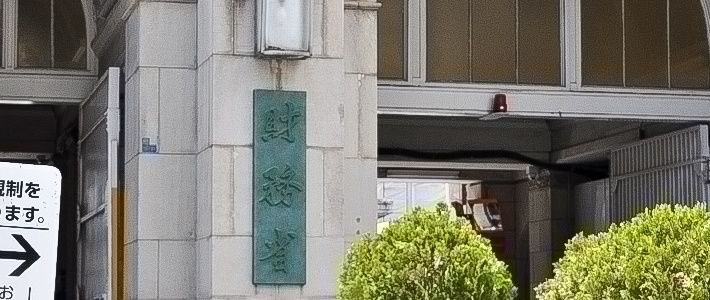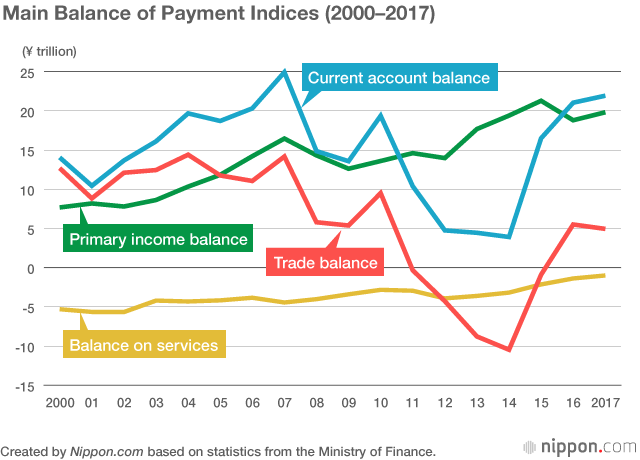
Japan Posts Second Highest Current Account Surplus in 2017
Economy Society- English
- 日本語
- 简体字
- 繁體字
- Français
- Español
- العربية
- Русский
Statistics released by the Ministry of Finance on 2017 balance of payments show that Japan’s current account balance, which indicates the overall state of its overseas trade, was ¥22.0 trillion in the black. This trade surplus, which is second only to the balance for 2007, reflects the ongoing benefits accrued from overseas-investment revenue and from the increase in foreigners visiting Japan.
Japan’s 2017 Balance of Payments
| (Unit: ¥ billion) | (% compared to previous year) | |
|---|---|---|
| Current account balance | 21,951 | 104.2% |
| Trade balance | 4,955 | 89.8% |
| Exports | 77,286 | 111.9% |
| Imports | 72,330 | 113.8% |
| Balance on services | –726 | 64.3% |
| Primary income balance | 19,837 | 105.4% |
Compiled by Nippon.com based on statistics from the Ministry of Finance.
Japan’s current account surplus had contracted from ¥19.3 trillion in 2010 to a low of ¥3.9 trillion in 2014, but the following year it expanded for the first time in five years—and since then it has been rising steadily. Prior to the 2011 Great East Japan Earthquake, the current accounts surplus had been buoyed by Japan’s trade surplus, but a structural change has emerged since the disaster so that the main pillars are now improvements in dividends from overseas securities investments and overseas subsidiaries, and in revenue from tourism.
The surplus in the trade balance accounted for ¥5.0 trillion of the current account balance. This is lower than the ¥5.5 trillion of the previous year, but still marks the second consecutive annual surplus. Increased sales of semiconductors and other manufactured goods, automobiles, and steel boosted exports to ¥77.3 trillion in 2017, a 11.9% increase over the previous year. The trade surplus was curbed by rising imports, centering on increases related to petroleum, coal, and other energy sources. Imports rose 13.8% over the previous year, to ¥72.3 trillion.

A Smaller Balance-on-Services Deficit
In contrast to other surpluses, the balance on services was in the red to the tune of ¥725.7 billion in 2017. But the margin of deficit shrank by 35.7% compared to the previous year. The deficit in the balance on services has been contracting over the long term, starting from 1996, when it stood at ¥67 trillion. Now that the deficit has finally fallen below ¥1 trillion, a future surplus is within sight.
The driving force in contracting the deficit in the balance on services last year was the ¥1.8 trillion surplus from tourism, marking the third consecutive year for its balance to be in the red. The number of foreign tourists visiting Japan set a new high in 2017, at 28.7 million, and this has expanded the tourism-related surplus significantly.
Royalties from intellectual property rights such as patents also posted a strong showing in 2017, at ¥2.3 trillion, marking the third straight year for the figure to exceed the ¥2 trillion mark. This revenue is the second main pillar, alongside that of tourism, for supporting the balance on services.
The balance on primary income, which includes the dividends earned by Japanese corporations from foreign securities investments and overseas subsidiaries posted a surplus of ¥19.8 trillion thanks to such factors as the expansion in income from direct investments. This level of the surplus is a 5.4% increase over the previous year. Although the surplus did not quite break the ¥20 trillion barrier, it is one of the structural factors sustaining Japan’s overall surplus in its balance of payments.
(Translated from Japanese. Banner photo: Ministry of Finance.)